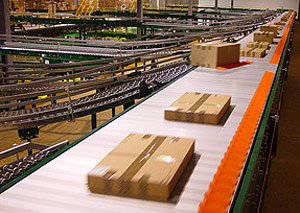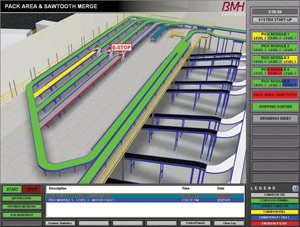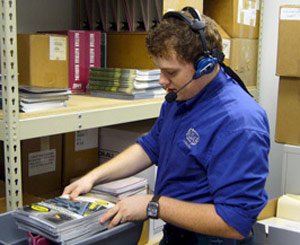
Material Handling Trends and Technologies Improving the Supply Chain
Stuart Schneider | 08 September 2011
Today's economic climate has put enormous pressure on companies to obtain quicker returns on their investments, so as manufacturers research and develop new material handling equipment, this issue is becoming increasingly important. Customers want solutions that offer not only a strong return on investment but do so faster than ever before. The material handling industry is responding with new equipment, technology, and systems that enable complete supply chain visibility, thus allowing customers to see how their investments are impacting their overall operation. The following are just a few of the trends and technologies helping to make this possible.
Equipment
- High-Speed Sortation Systems -- Sortation systems are used in distribution centers and warehouses to sort products to specific storage zones as well as route products to specific dock doors for shipping. High-speed sorters, common in distribution centers, are designed to provide higher throughput, operate quieter than previous designs, and are also easier to maintain. All of these lead to increased efficiencies and a better, quicker return on investment (ROI).
- Motorized Roller Conveyor -- Manufacturers of conveyor systems are also listening to these needs. A rapidly emerging technology in the live-roller conveyor arena is the 24-volt motorized roller (MDR) conveyor. MDR retains most of the positive features of line-shaft or belt-driven live rollers but adds a number of unique advantages. In conventional conveyors, a gear motor (with rotating shaft) or belts drive the operation, but with MDR conveyor, a 24-volt DC motor drives the system.

This allows for a high degree of flexibility and modularity in conveyor design. The plug and play zones make inserting a divert, merge, or other module much easier than in conventional designs. The MDR's per foot cost is sometimes higher than conventional conveyor depending on the application, but it is a safe design. Each zone can be stopped safely with a bare hand.
There is also reduced wiring cost and simplified diagnostics incorporated into the controls. A major cost savings is the reduction of electrical power to run the units. Also, facilities using MDR conveyors show significant drops in the noise level (as low as 65 dba), a positive ergonomic feature.
Technology and Software
- Warehouse Control Systems-- In the past, material handling control systems were often considered just a collection of mechanical and control devices that cause objects to move from one place to another within the walls of a manufacturing, warehouse, or distribution facility. They were often treated as an inconvenient necessity, simply conveyor or sorter controls rather than a competitive opportunity.
 Today, more advanced control systems provide an interface between material handling equipment and upper-level software applications. This interface facilitates the exchange of information and data between equipment, such as conveyors or sorters, and data-rich software, such as a warehouse management system (WMS).
Today, more advanced control systems provide an interface between material handling equipment and upper-level software applications. This interface facilitates the exchange of information and data between equipment, such as conveyors or sorters, and data-rich software, such as a warehouse management system (WMS).
Even more advanced control systems are often called warehouse control systems (WCS). Typically, a WCS provides a single-point interface that coordinates all other equipment and system interfaces within its software. For example, a WCS might integrate the WMS with the real-time controls of all equipment within the supply chain.
A WCS can be considered the middleware link or the glue between the floor automation and the decision making, upper-level software. The floor automation encompasses many components: bar-code scanners, vision systems, scales, label print and apply systems as well as traditional material handling controllers that operate conveyors, sorters, automated storage and retrieval systems (ASRS), carousels, automated guided vehicles (AGVSs), and other material handling sub-systems.
Architected and configured correctly, a WCS can bridge operational gaps between organizations and customers by providing real-time data to speed up processes, information, and delivery.
 Voice Picking -- Technological advancements such as voice recognition systems are steadily gaining in popularity as more industries discover their benefits and learn to use them effectively. In the manufacturing environment, voice picking systems can provide increased productivity and reduced errors while picking parts for a kit or items for an order.
Voice Picking -- Technological advancements such as voice recognition systems are steadily gaining in popularity as more industries discover their benefits and learn to use them effectively. In the manufacturing environment, voice picking systems can provide increased productivity and reduced errors while picking parts for a kit or items for an order.
Voice recognition systems provide direct, hands-free communication between operators and a computer via the headset. Operators are able to keep both hands on the equipment they are operating while receiving instructions from the computer, resulting in a safer working environment. The ability to use both hands can also increase the amount of work an operator performs, which could lead to an increase in throughput and quicker ROI.
Communication and Visibility
The concept of supply chain visibility has been gaining momentum as more manufacturers learn the value of looking at the entire supply chain. Optimizing performance within the manufacturing operation is no longer enough to generate the level of cost reduction and quality improvements needed to remain competitive.
As new technology becomes available, companies are looking for systems that connect with each other, both internally and externally, for greater visibility throughout the supply chain and for information sharing.
Manufacturers need a faster, more accurate flow of information for processing and handling systems, both on the factory and warehouse floors. These systems must then be interconnected to communicate to higher-level information systems such as a WMS so that customers can see the status of their parts and materials in real time.
Decision making will also be pushed down to the factory and warehouse floors as equipment and software have the increased ability to talk to each other. This provides decision makers with greater insight into the true status of their processes, so adjustments to schedules, manpower, and other resources can be made proactively instead of reactively.
Interconnected systems will also automate communication between machines, so processes can be adjusted as needed in real time. For example, a conveyor system might have unplanned downtime that will delay shipment of parts by an hour. If those parts are being delivered Just in Time (JIT) to another factory, this information can be communicated upstream and adjustments to schedules can be made to eliminate downtime in the upstream process.
Today's material handling systems combine complex machinery and information technology that can facilitate value-added operations and contribute to supply chain excellence. Systems must be carefully integrated with one another and both information technology and physical systems have to be flexible, scalable, and easily updated.
Comments
No comments have been posted to this Blog Post
Leave a Reply
Your email address will not be published.
Comment
Thank you for your comment.